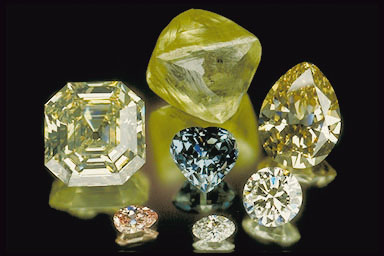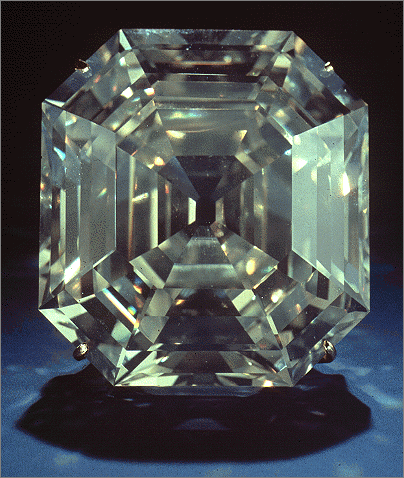The Portuguese Diamond

Photo by Chip Clark
The Portuguese Diamond at 127.01 carats is the largest faceted diamond in the Nation Gem Collection. It's near flawless clarity and unusual octagonal emerald cut make it one of the world's most magnificent diamond gems. It is perhaps more than a little surprising, then, that so little documented information exists about it's origin and early history. The lack of an authoritative provenance, however, has given rise to considerable conjecture and legend. The diamond owes its current name to one such legend, according to which the diamond was found in Brazil in the eighteenth century and became part of the Portuguese Crown Jewels. There is no documentation, however, that substantiates a Brazilian origin or connection to Portuguese royalty, nor is it clear where or from whom this story originated. As it is discussed below, the diamond most likely was found at the Premier Mine in Kimberly, South Africa, early in the 20th century.

The Portuguese Diamond among other notable diamonds in the Smithsonian's collection:
Interestingly, the extensive media coverage that followed exhibitions of the diamond around the country during 1946-47 made no reference to the diamond by its current name or to a Portuguese or Brazilian connection. Instead other, sometimes conflicting, versions of the history of the diamond were presented. Most accounts indicate that the diamond, which was owned at the time by a syndicate of American diamond dealers, had mysteriously appeared in Amsterdam some years earlier as a rough cut, cushion-shaped stone weighing 187 carats, which was re cut into its present form.
This original cushion shape was not 187 carats, but rather, 150, which has been quoted by several different sources. I'd trust the Smithsonian's word for it, though. If anybody could research it, They also state that diamond dealers all over the world were puzzled by the diamond's lack of history and had tried to trace its origin without success. One article, on the other hand, indicated that the diamond had originally belonged to an Indian potentate who had pawned it in London. During this period when the diamond was exhibited at jewelry stores across the country it was suspended as a pendant from a platinum band set with 380 small diamonds.
One part of the diamond's history that is well-documented is that in February 1928 Peggy Hopkins Joyce acquired the diamond from Black, Starr & Frost. She traded a $350,000 pearl necklace for the diamond and $23,000 in cash. According to New York newspaper accounts, it was mounted on a diamond-studded platinum choker to be worn close around the throat (probably the same necklace described above). The jewelry firm's spokesperson at the time indicated that the diamond was found at the Premier Mine, Kimberly, South Africa, in 1910, and that the firm had obtained it shortly after its discovery. Miss Joyce was dazzling blonde who performed in the Ziegfeld Follies, a true glamour girl of the 1920s. She had six husbands, at least five of whom were men of wealth, and claimed to have been engaged fifty times. She was said to be almost as fond of jewels as of men. Sometime prior to 1946 Miss Joyce placed the diamond on consignment to the group of jewelers mentioned above, in an unsuccessful attempt to sell it.
Harry Winston acquired the Portuguese Diamond from Miss Joyce in 1951, and for the next several years it traveled the country as part of his "Court of Jewels" exhibition. In 1957, Winston sold the diamond to an international industrialist, who then traded it back in 1962. In 1963, the Smithsonian acquired the Portuguese Diamond from Mr. Winston in exchange for 2,400 carats of small diamonds.
The Portuguese Diamond strongly fluoresces blue under ultraviolet light. A soft fluorescence is visible even in daylight or artificial light and gives the stone a slight bluish haze, enough so that it was once advertised as the "largest blue diamond in the world." In fact, if not for the fluorescence, the diamond would appear slightly yellowish.
Portuguese Diamond is a world famous diamond residing in the Smithsonian Institute in Washington DC. There are several legends regarding the origin of the Portuguese Diamond. According to one of these legends, the diamond was found in the early 20th century at the Premiere Mine in Kimberly, South Africa.
There is no mention of the Portuguese Diamond having any Portuguese or Brazilian connections in the historical documents related to it. Instead, in most accounts there is an indication about the diamond being owned by an organization of American diamond dealers. This diamond appeared in Amsterdam quite mysteriously. The stone was of a rough cut and was shaped like a cushion. It weighed around 187 carats.
The Portuguese Diamond is an unusual Octagonal Emerald cut known for its flawlessness and clarity. It weighs 127.01 carats and is regarded as one of the world’s most magnificent diamond gems.

